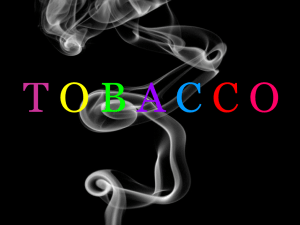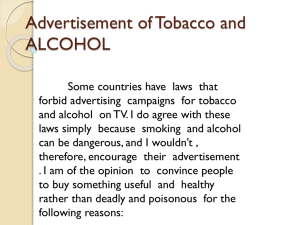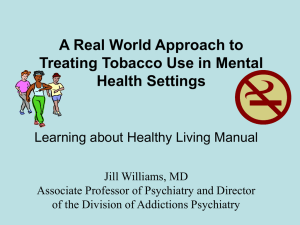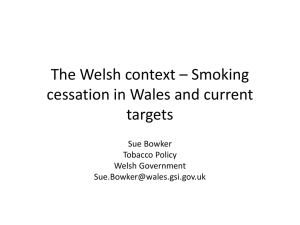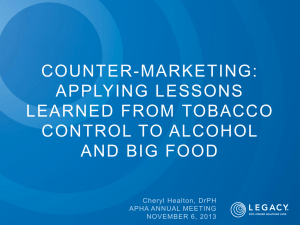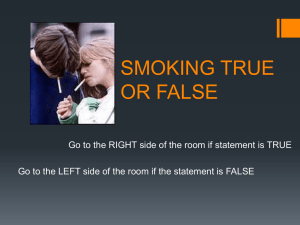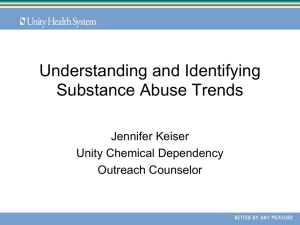DSM V: A New Paradigm of Addiction
advertisement
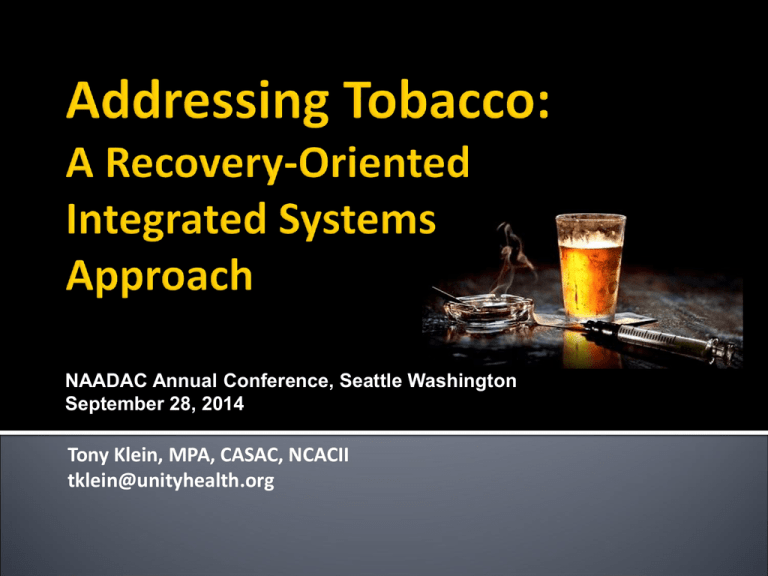
NAADAC Annual Conference, Seattle Washington September 28, 2014 Tony Klein, MPA, CASAC, NCACII tklein@unityhealth.org Individuals with SUD/COD are more vulnerable to tobacco use disorder. Tobacco use behavior is most often fundamental to the use rituals of other substances. Fully integrated tobacco interventions in addiction services improves treatment outcomes. Effective implementation strategy must include provision to denormalize tobacco use in the treatment and recovery culture. Behavioral Health providers have highly developed clinical competencies to treat tobacco addiction. SENSORIAL CHEMICAL PHYSICAL CIGARETTE PERCEPTUAL COGNITIVE PSYCHOLOGICAL Philip Morris Sensory Technology Operation Plans, 1991 Philip Morris Behavioral Research Lab Project 1620 “…to study the basic dimensions of the cigarette as they relate to cigarette acceptability…[and] to record and interpret changes in smoke inhalation patterns [and nicotine retention] in response to changes in smoke composition”, and “to develop a better understanding of the actions of nicotine and other smoke compounds, especially those which reinforce the smoking act.” Nicotine & Tobacco Research, Volume 6, Number 6, December 2004 USA Adult Smoking Rate = 18.1% (Median) Washington State Adult Smoking Rate = 15.7% Oregon Adult Smoking Rate = 19.7% California Adult Smoking Rate = 12.6% New York State Adult Smoking Rate = 16.2% Center for Disease Control, 2012 Addiction Treatment = 60 to 95% Serious Mental Illness = 36 to 90% Professional Development Program, Rockefeller College, SUNY at Albany, The Foundation: Integrating Tobacco Use Interventions into Chemical Dependence Services, 2008 Morris et al., 2009 Major depression Bipolar disorder Schizophrenia * Anxiety disorder PTSD Alcohol abuse Other drug abuse 36 - 80 % 51 - 70 % 62 - 90 % 32 - 60 % 45 - 60 % 34 - 93 % 49 - 98 % Prevalence rates by diagnostic category across studies. Morris et al., 2009 *20% of persons with schizophrenia started smoking at college age, and many began in treatment settings, receiving cigarettes for “good behavior.” National Association of State Mental Health Program Directors, 2007 Nearly half of all cigarettes in the United States are consumed by individuals with an addiction or mental illness. Grant, 2004; Lasser, 2000 Why Individuals With COD Have Higher Rates of Tobacco Dependence The pathophysiology of these disorders increases vulnerability to nicotine dependence. Individuals with are self-medicating affective and cognitive deficits associated with these disorders. Social factors (e.g., peer modeling, settings). Kalman, Morrissete and George, 2005. Am. J. Addict. 14: 106-123 Number of Deaths (thousands) Tobacco use was the cause of death in 51% of alcoholics who completed inpatient treatment examined over a 20-year period post treatment. Individuals with mental illness or substance use disorders Hurt et al. 1996 Among males with heroin addiction, tobacco use was responsible for more deaths than accidental drug poisoning/overdose, suicide/homicide/accidents, and chronic liver disease examined over a 33-year period. Hser et al. 2001 AIDS Obesity Alcohol Motor Homicide Drug Suicide Vehicle Induced Tobacco Centers For Disease Control and Prevention: Comparative Causes of Deaths in the United States, 2004 Neurobiological Psychological Social Nicotine in Cigarettes is used for: Pleasure; Enhanced Performance Self-medication; Mood regulation Withdrawal Symptoms Dysphoric or Depressed Mood; Irritability; Increased Appetite; Difficulty Concentrating; Insomnia; Urge to Smoke; Anxiety; Restlessness; Decreased Heart Rate; Light Headedness Tolerance and Physical Dependence Tolerance related to up-regulation -increased number and desensitization of nicotine receptors; 2 hour half life and rapid clearance from CNS (1) Foulds J. Int J Clin Pract 2006. 60 571-576; (2) Diagnostic and Statistical Manual of Mental Disorders, 4th Ed, Washington DC, APA. 2000 266. Nicotine has a cascade effect on a variety of neurotransmitters and is one of the most potent stimulants of the midbrain dopamine reward pathway. Pomerleau, 1992 Drug action of nicotine releases: Excitatory, Activating, Stimulating neurotransmitters Norepinephrine Glutamate Inhibitory, Calming, Relaxing neurotransmitters GABA Serotonin Rewarding neurotransmitters Dopamine Analgesic neurotransmitters Endorphins Enkephlins Negative Affect (Mood Modulation) Acute Withdrawal Syndrome Primary Secondary Positive Effects (Satisfaction and Reinforcement) DA, NA, 5-HT DA, NA, GABA Stress DA, NA, ACh, Glu DA, EOP, NA, Glu Tobacco Use Maintenance and Relapse EOP, ECB DA, ACh, 5-HT, Glu, GABA Antinociception Conditioned Cues (Protracted Abstinence) DA, EOP, ECB Weight Control DA, NA, ACh, Glu Cognitive Enhancement Figure 1. State, trait and environmental factors, and neurotransmitter systems that mediate smoking maintenance and relapse. The blue circles represent primary contributors to smoking maintenance and relapse, whereas the green circles represent secondary contributors to those processes. Abbreviations: ACh, acetylcholine (nicotinic ACh receptor); DA, dopamine; ECB, endocannabiniod (CB, receptor); EOP, endogenous opioid peptide; Glu, glutamate; 5-HT, 5-hydroxytrypamine; NA, noradrenaline. George T.P. and O’Malley S.S. Trends Pharmacology. Sci. 2004;25:42-48. Nicotine affects the same neural pathway as alcohol, opiates, cocaine, and marijuana. Pierce & Kumaresan, 2006 Tobacco use reinforces the effects of alcohol and cocaine. Little, 2000; Wiseman & McMillan, 1998 Tobacco use has a modulating effect by reducing cocaine-induced paranoia. Wiseman & McMillan, 1998 Tobacco use in an population with SUD maintains… rituals and social norms that serve to reinforce substance abuse coping beliefs drug dealing behavior and lifestyle a rationale for manipulative and secretive behavior As one walks through a drug recovery process, the cigarette is often the last thread of a tangible link to one’s old (person active in addiction) identity while developing a new (person in recovery) identity. Tobacco use provides a sense of familiar comfort, yet often inhibits growth to key objectives of recovery: cognitive and behavioral change to redefine self and lifestyle. Therapeutic Community Harlem NYC 45 – 50 Adult Males Community Meeting Tobacco Awareness Group Odyssey House Two Fundamental Goals: 1. “Denormalize” tobacco use within the treatment & recovering community culture. 2. Provide treatment to assist clients to establish and maintain tobacco abstinence as part of “a day at a time” recovery. Two Levels of Behavioral Counseling to Match Intervention to Patient Stage-Readiness: Tobacco Awareness (Cognitive) Engagement Develop Interest Highlight Importance Advance Stage-Readiness Tobacco Recovery (Behavioral) Learn Coping Skills Elevate Confidence Embrace Lifestyle Change Always with Pharmacotherapy Treatment Implications Client Stages and Processes Stages of change Pre-contemplation (not thinking about change) Treatment Stages and Interventions Processes of change Engagement Experiential: Contemplation/ Preparation (thinking, planning) Cognitive learning Emotional learning Consciousness-raising Dramatic relief Environmental re-evaluation Self re-evaluation Action (making the change) Behavioral: Maintenance (maintaining change) Social liberation Contingency management Helping relationship Counter-conditioning Stimulus control Stages of Treatment Treatment Goals Treatment Interventions Pre-engagement (no contact with provider) Make contact Outreach Engagement (no regular contact) Create an alliance Persuasion Early persuasion (regular contact) TOBACCO Late persuasion (target AWARENESS behavior <1 mo.) Active Treatment TOBACCO RECOVERY Relapse Prevention TOBACCO RECOVERY Active early ( target behavior> 1mo.) Late active (targeted behavior change 1-5 mos.) Relapse Prevention (target change sustained over 6 mos.) Practical assistance Stabilizing symptoms Increase client Motivational motivation interviewing Education Peer persuasion groups Help client change CBT Social Skills Training Stress Mgt Self-help groups Pharmacological treatment Note relapse risk Peer recovery Build on recovery groups Self-help groups Lifestyle improvements Based on Center for Mental Health Services (CMHS), 2003; Center for Substance Abuse Treatment, 2005; Mueser et al., 1999; Prochaska & DiClemente, 1983; Prochaska, 1992. Working Definition of Recovery A process of change through which individuals improve their health and wellness, live a self-directed life, and strive to reach their full potential. U.S. DEPARTMENT OF HEALTH AND HUMAN SERVICES Substance Abuse and Mental Health Services Administration www.samhsa.gov Embrace Recovery! Be Alcohol, Tobacco & Drug-Free Alcoholics provided [tobacco dependence treatment] during addictions treatment was associated with a 25% increased likelihood of long-term abstinence from alcohol and illicit drugs. Prochaska et al., Journal of Consulting and Clinical Psychology, 2004 Meta Analysis of 19 Randomized Control Trials with Individuals in Current Treatment or Recovery. All smokers with psychiatric disorders, including substance use disorders, should be offered tobacco dependence treatment, and clinicians must overcome their reluctance to treat this population. Clinical Practice Guideline, 2008 Update, p 154. Alcoholics who quit smoking are more likely to succeed in alcoholism treatment. Shiffman & Balabanis,1996 Nicotine craving and heavy smoking may contribute to increased use of cocaine and heroin. National Institute on Drug Abuse, 2000 Non-tobacco users maintain longer periods of sobriety after inpatient treatment for alcohol/drug dependence than tobacco users. Stuyt, 1997 The Charles K. Post Addiction Treatment Center is a state-operated inpatient treatment program which is Commission on Accreditation of Rehabilitation Facilities (CARF)-accredited and NYS OASAS-certified. C.K. Post opened in 1955. The facility maintains 79 beds for its inpatient rehabilitation program and 21 beds for its Community Residential program. Services provided include routine medical care, specialized and individualized treatment and educational services, as well as other types of interventions that address the physical, psychological, emotional, and social symptoms of addiction. Charles K. Post Addiction Treatment Center Pilgrim Psychiatric Center West Brentwood, NY Tobacco Addiction Should be Treated in AOD Programs 50 46 45 40 34 30 20 30 22 20 N = 59 46% Nov 17 / 54% New AWARENESS TOPICS 1 - Tobacco Use and Other Substances 2 - Decisional Balance 3 - Letting Go of Unhealthy Relationships 4 - Review / Behavioral Defenses 15-Dec 5 Tobacco Use and Other N=61 Substances 44% Dec 1 / 56% New Mean = 3.3 Principal Mode = 5 (20) Secondary Mode = 1 (12) Mean = 3.3 Principal Mode = 5 (28) Secondary Mode = 1 (18) 10 0 17-Nov 1-Dec N = 64 Mean = 2.4 Principal Mode = 1 (29) Secondary Mode = 5 (14) Strongly Agree Strongly Disagree Klein, Tony. Charles K. Post Addiction Treatment Center, Tobacco Intervention Project, 2008 Outreach Training Institute, Regional Technical Assistance & Training Center, Professional Development Program, SUNY at Albany Stopping Tobacco at the Same Time as Other Substances is a Good Idea 40 38 36 36 32 30 27 Strongly Agree Strongly Disagree 20 16 10 0 17-Nov 1-Dec N = 64 Mean = 2.4 Principal Mode = 1 (29) Secondary Mode = 5 (14) 15-Dec AWARENESS TOPICS 1 - Tobacco Use and Other Substances 2 - Decisional Balance 3 - Letting Go of Unhealthy Relationships 4 - Review / Behavioral Defenses 5 - Tobacco Use and Other Substances N = 59 46% Nov 17 / 54% New N=61 44% Dec 1 / 56% New Mean = 3.3 Principal Mode = 5 (20) Secondary Mode = 1 (12) Mean = 3.3 Principal Mode = 5 (28) Secondary Mode = 1 (18) Klein, Tony. Charles K. Post Addiction Treatment Center, Tobacco Intervention Project, 2008 Outreach Training Institute, Regional Technical Assistance & Training Center, Professional Development Program, SUNY at Albany Nicotine Replacement Therapy is Helpful 60 50 49 40 37 30 20 Strongly Agree Strongly Disagree 27 22 17 N = 59 46% Nov 17 / 54% New AWARENESS TOPICS 1 16 - Tobacco Use and Other Substances 2 - Decisional Balance 3 - Letting Go of Unhealthy Relationships 4 - Review / Behavioral Defenses 15-Dec 5 Tobacco Use and Other N=61 Substances 44% Dec 1 / 56% New Mean = 3.3 Principal Mode = 5 (20) Secondary Mode = 1 (12) Mean = 3.3 Principal Mode = 5 (28) Secondary Mode = 1 (18) 10 0 17-Nov 1-Dec N = 64 Mean = 2.4 Principal Mode = 1 (29) Secondary Mode = 5 (14) Klein, Tony. Charles K. Post Addiction Treatment Center, Tobacco Intervention Project, 2008 Outreach Training Institute, Regional Technical Assistance & Training Center, Professional Development Program, SUNY at Albany Anchor the rationale for addressing tobacco to the organization’s mission. Develop a written ATOD policy. Integrate tobacco treatment into existing programming. Highlight the topic as a recovery issue communicated through treatment philosophy, 12-Step teachings and/or therapeutic community principles. Strategically address the resistance to social change. Provide targeted staff training after completing a needs assessment; match training to agency stage-readiness. Utilize Quality Improvement Process and Clinical Supervision to sustain clinical interventions. Use language consistent with treatment and recovery culture. Cultivate a consensus of all stakeholders. Current System Intake/Assessment Orientation Treatment Planning Program Therapies Psychoeducation Case Review/QI Discharge Planning Change Related Tasks Alcohol, Tobacco, & Drug-Free Policy Use Language Consistent to Recovery Culture, 12-Step Teachings and Therapeutic Community Principles Common Terminology Smoking Quit date Cessation Language to Promote Social Change Tobacco Use, Hit, Fix Tobacco Recovery Start Date Treatment, Recovery The language we use is fundamental in creating environments conducive to a recovery process. Think parallel process for clients and staff Meet people where they are Strive to understand staff perspective Wherever possible, offer options Roll with resistance non-reactively Avoid willfulness Support staff initiatives for change Partner with staff to tailor interventions for their practice context Miller & Rollnick, 2001; Williams et al., 2006 www.oasas.ny.gov/tobacco/index.cfm Training Tools to Support Your Tobacco-Free Efforts These FREE training videos are designed to reinforce the importance of addressing tobacco with counselors and clients COUNSELOR VIDEO CLIENT VIDEO This poster has been designed to reinforce the importance of an alcohol, drug and tobacco-free life in recovery. DOWNLOAD POSTER . Find the free, downloadable files you need to implement the curriculum in your education or training program: Trainer Manuals Participant Manuals PowerPoint slides Integrating Tobacco Use Interventions into Chemical Dependence Services is a comprehensive, state-of-the-art modular curriculum that motivates, educates, and empowers addiction and allied health professionals to integrate evidence-based tobacco interventions into prevention, treatment, and recovery programs. When I stopped living in the problem and began living in the answer, the problem went away. Big Book of Alcoholics Anonymous Page 449 tklein@unityhealth.org 585.368.4718


